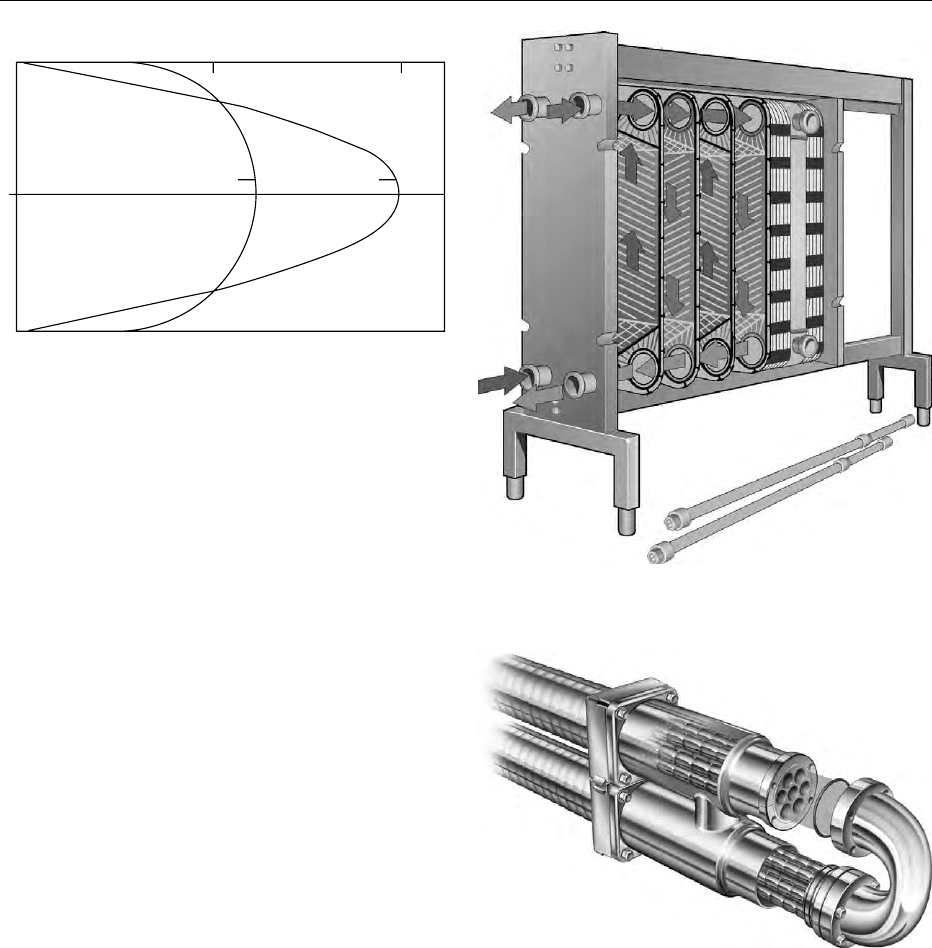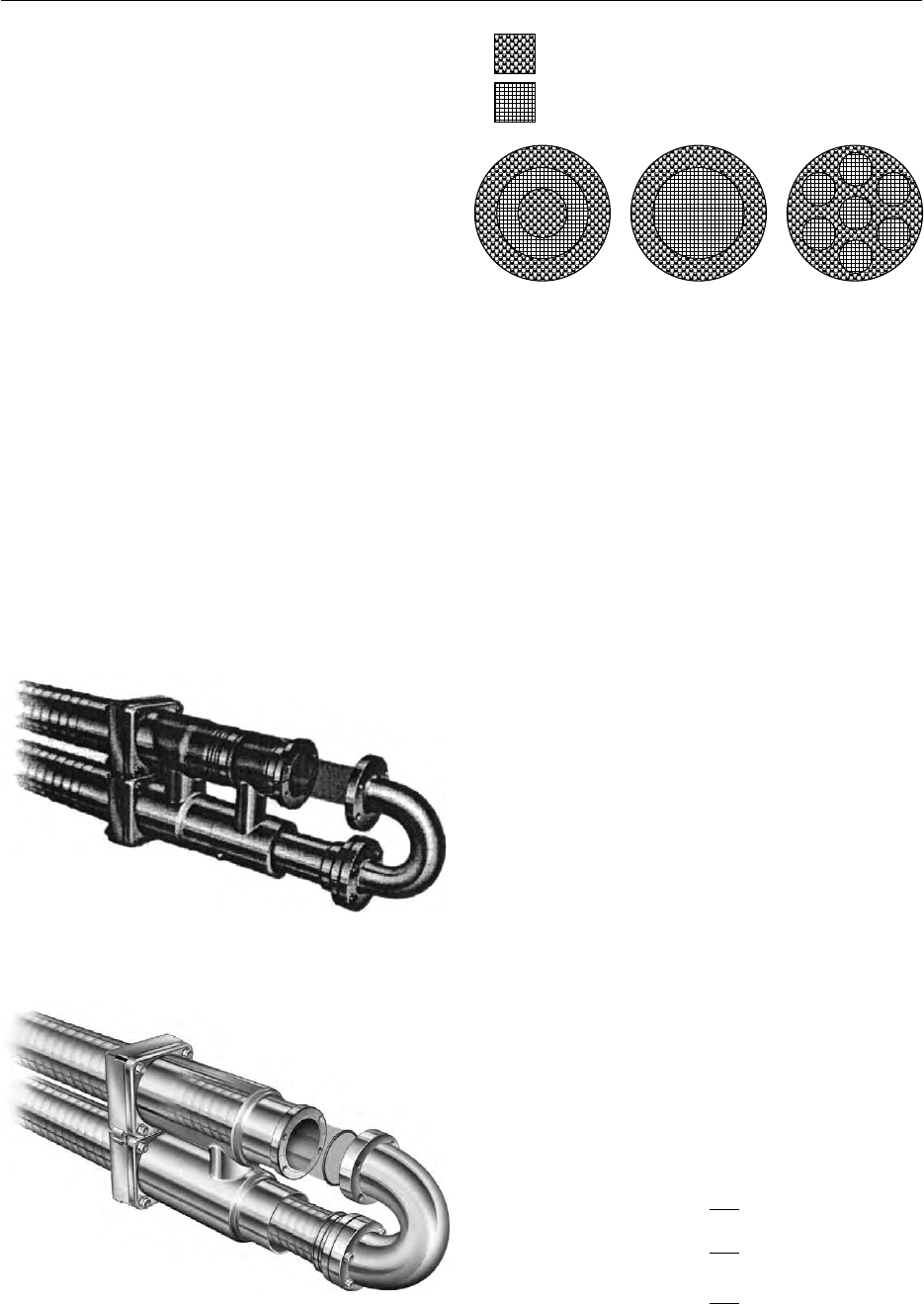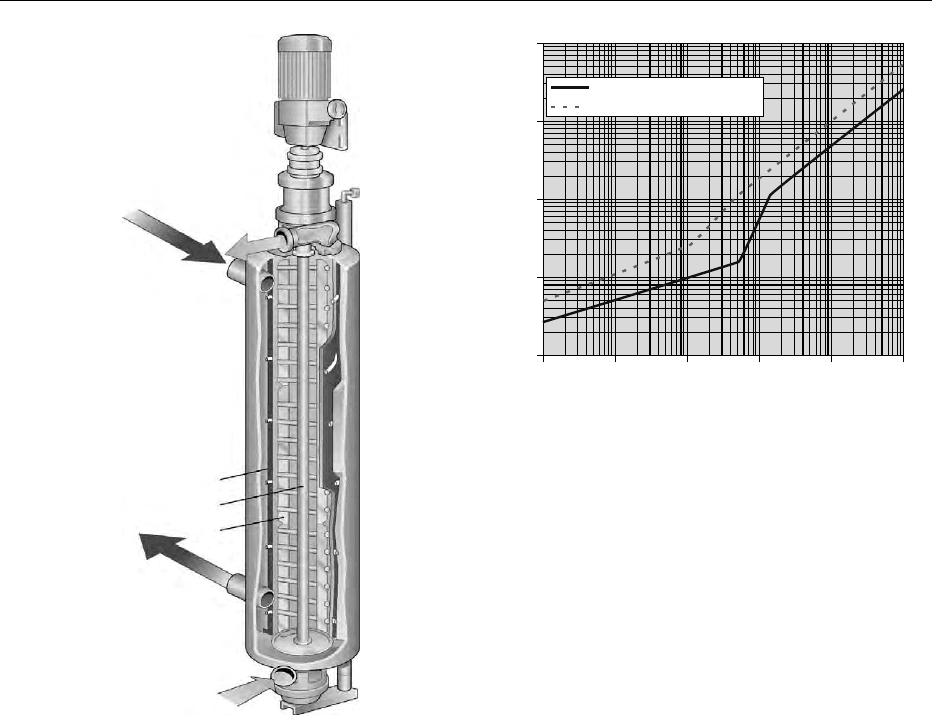Caballero B. (ed.) Encyclopaedia of Food Science, Food Technology and Nutrition. Ten-Volume Set
Подождите немного. Документ загружается.


See also: Browning: Nonenzymatic; Enzymatic –
Biochemical Aspects; Emulsifiers: Organic Emulsifiers;
Uses in Processed Foods; Homogenization;
Pasteurization: Principles; Vitamins: Overview
Further Reading
Cunningham FE (1995) Egg product pasteurization. In:
Stadelman WJ and Cotterill OJ (eds) Egg Science and
Technology, 4th edn. Binghampton: Haworth Publish-
ing.
Hyde A (1999) Heat transfer processes in breweries – part
3. Ferment 12: 30–34.
Lewis MJ and Heppell NJ (2000) Continuous thermal pro-
cessing of foods: pasteurization and UHT sterilization.
Gaithersburg: Aspen.
Zufall C and Wackerbauer K (2000) The biological impact
of flash pasteurization over a wide temperature interval.
Journal of the Institute of Brewing 106: 163–167.
Pasteurization of Viscous and
Particulate Products
G Tucker, Campden & Chorleywood Food Research
Association, Chipping Campden, UK
Copyright 2003, Elsevier Science Ltd. All Rights Reserved.
Background
0001 For food products of high viscosity, the choice to
pasteurize in a continuous system has distinct advan-
tages over one where the process takes place in the
container (see Figure 1). This is because the heat
transfer from a heating or cooling medium to a vis-
cous food is far from ideal, but careful design and
selection of the heat exchange system can overcome
this limitation. Of principal concern are the econom-
ics of food production, which become attractive in
continuous systems for high volumes and long
production runs. Further economic benefits can be
realized by minimizing the product’s exposure to the
adverse effects of high temperatures, long processing
times and high shear preparation methods, resulting
in improved product quality, reduced processing
costs, increased safety, and increased plant through-
put. This chapter considers both continuous and in-
container processing systems.
Continuous Processing Considerations
0002 A challenge in the design of heat-transfer equipment
are the so-called prepared food products, such as
tomato products, soups and sauces, and dessert prod-
ucts. These products are normally of high viscosity as
well as of complex composition. Also, in most cases,
the particle content is significant. With respect to the
rheological or flow behavior, the products are typic-
ally non-Newtonian, showing, in many cases, quite
extraordinary behavior.
0003The microbiological demands of a pasteurization
process are still to achieve commercial sterility, i.e.,
the end product must be free from pathogenic and
spoilage organisms capable of growth under nor-
mal storage and distribution conditions as well as
being free from toxins. Depending on the rheological
properties of the product and the possible presence of
particles, the design and choice of equipment can vary
significantly from case to case.
Flow Behavior
0004In the design and choice of heat exchangers, the flow
behavior of the product has to be taken into consider-
ation. The flow behavior will affect, for instance, the
residence time distribution and hence the design of
heat exchangers and holding cells to obtain the suffi-
cient thermal treatment. The basic difference between
laminar (streamline) and turbulent flow is well
known (see Figure 2), as is the effect on the velocity
profile from heating or cooling of the product. For
example, the maximum velocity in laminar flow is
theoretically twice the mean velocity, and in turbulent
0
50
100
150
Temp.C
20 40 60 80 100 120
Minutes
Continuous
processing
In-container
processing
fig0001Figure 1 Time/temperature graph for comparison of in-
container and continuous processes.
PASTEURIZATION/Pasteurization of Viscous and Particulate Products 4395

flow around 10% higher. For viscous products, how-
ever, the flow conditions are nearly always laminar.
0005 For liquid foods that have a complex flow behavior
the velocity profiles in pipe-flow depend on the flow
behaviour index. This index can range from 1.0 in
simple materials such as water, milk, or fruit juice, to
0.7 in starch-based sauces, to 0.3 in tomato paste, and
in theory can go to 0.0. With decreasing flow behav-
ior index, the velocity profile increases in flatness,
which means in practice that the maximum velocity
decreases from twice the mean velocity. Maintaining
the factor of two for the calculation of the necessary
holding cell length thus creates overcooking of the
product, but it is a safe assumption and one that
most of the industry adopts.
0006 A further complication to the viscous flow behavior
arises with additives that give elastic properties, e.g.,
xanthan or gellan gum. These are sometimes used to
enhance the particle-carrying properties for a carrying
fluid in continuous processing. The so-called yield
value, which normally is a measure of the product’s
willingness to flow by itself, e.g., from a storage tank,
is also a measure of the particle carrying abilities. A
significant yield value, typical of paste-like products,
also adds to the flatness of the velocity profile.
Choice of Heat Exchanger
0007 The choice of optimal heat exchanger depends to a
great deal on the flow conditions. Fluids with low
viscosities and no particles are preferably treated in
a plate heat exchanger (see Figure 3). This is the most
economic option. The food product and heating (or
cooling) media flow in alternate channels to provide
good heat-transfer characteristics. The plates are 0.5–
1.25 mm thick, separated by 3–6 mm, and sealed with
gaskets.
0008For fruit juices with pulp and fibers up to 5 mm in
length, special types of plates are available with wide
gaps. Even with foods of higher viscosities, the plate
heat exchanger can be utilized as long as the pressures
developed are not too high, which can cause failure of
the gaskets. Attempts to pasteurize foods with par-
ticles can result in blocked flow channels and in-
creased pressure until the gaskets fail.
0009For fruit juices with fibers up to 15 mm in length, a
multitube tubular heat exchanger (see Figure 4)is
preferable to the plate heat exchanger. Also, foods
of moderate to high viscosity with only small particles
(< 5 mm) will flow through a multitube exchanger
Turbulent flow
012
Laminar flow
fig0002 Figure 2 Velocity profiles for turbulent and laminar (stream-
line) flow showing the ratio of maximum velocity to average
velocity.
fig0003Figure 3 Plate heat exchanger.
fig0004Figure 4 Multitube tubular heat exchanger.
4396 PASTEURIZATION/Pasteurization of Viscous and Particulate Products

without problems. The typical inside diameter of each
tube is 14 mm, and these can be grouped in bundles of
four, seven, 12, 19, 27, or 37 tubes. Other combin-
ations of tube diameters and tube bundle numbers are
available, depending on the equipment supplier. Most
commercial tubular heat exchangers are 6 m long.
0010 However, if the fluid is significantly viscoelastic, i.e.,
exhibits a large yield value, often in combination with
a high viscosity, there is a risk of maldistribution across
the tubes of a multitube exchanger. In the worst case,
the product flow will stop in some of the tubes, causing
overcooking of parts of the product and subsequent
cleaning problems. Examples of such products are hot
break tomato paste or a stiff dessert pudding. In these
cases, the concentric tube is the best choice, which has
only one product channel and eliminates this risk. At
the same time, the narrow gap and the two service
medium channels surrounding the product channel
provide efficient heat transfer (see Figure 5).
0011 Finally, if large particles are present, the monotube
is the optimal choice of tubular heat exchanger (see
Figure 6). The drawback with a monotube compared
to multi- or concentric tubes is a reduced thermal
efficiency due to the thicker product layer. This is
illustrated in Figure 7, which shows the cross-
sectional flow areas of each tube type. However, to
a great extent, the particles present in the product will
work as ‘internal mixers’ and hence will promote heat
transfer.
0012If the food viscosity is high, and there is the chance
of product fouling the heated or cooled surfaces of a
tubular heat exchanger, the scraped surface heat ex-
changer must be employed (see Figure 8). In principle,
a scraped surface heat exchanger is a monotube
equipped with a rotating internal scraper. The scraper
keeps the heating surface free from any deposits and
also promotes turbulence. Hence, this type of heat
exchanger is ideal for products of a very high viscos-
ity, possibly also containing large particles.
Heat-transfer Correlations
0013Design models for heat exchangers are normally
based on empirical correlations of the dimensionless
Nusselt, Prandtl, and Reynolds numbers. The derived
equation is basically of the form Nu ¼f(Re, Pr). By
using dimensionless numbers, only a limited number
of experiments have to be performed in which the
product and heating/cooling medium flow rates and
the product physical properties are varied in order to
cover a large range of Reynolds as well as Prandtl
numbers. The physical properties are changed prefer-
ably by changing the temperatures of the fluids in-
volved. Decreased and increased temperatures can
normally vary the viscosity of the product signifi-
cantly.
0014The definition of the Nusselt (Nu), Prandtl (Pr)and
Reynolds (Re) numbers is as follows:
Nu ¼
ad
h
Pr ¼
c
p
Re ¼
d
h
fig0005 Figure 5 Concentric tubular heat exchanger.
fig0006 Figure 6 Monotube tubular heat exchanger.
Concentric tube
Heating or cooling media
Product
Mono tube Multi tube
fig0007Figure 7 Cross-sectional tube designs for tubular heat
exchangers.
PASTEURIZATION/Pasteurization of Viscous and Particulate Products 4397

where a is the individual heat transfer coefficient
(W/m
2
K
1
); d
h
is the hydraulic diameter (m); l is
the thermal conductivity of liquid (W/m
1
.K
1
); c
p
is the specific heat of liquid (J/kg
1
.K
1
); m is the
dynamic viscosity of liquid (Pa.s); v is the velocity
(m.s
1
) and r is the density (kg.m
3
). A comparison
of tubular heat exchangers with plate heat exchangers
shows that the thermal performance, as read off in a
typical Nu–Pr–Re graph, is better for the plate heat
exchanger, mainly due to the complex corrugated
pattern including a large number of contact points
in the product channel (see Figure 9).
0015 From systematic laboratory tests and from experi-
ence of commercial plants, it has been found, how-
ever, that to completely model the heat transfer of
liquid food products, several more parameters have
to be included. Such parameters include, for instance,
particle content, particle shape, and size as well as the
type of particles. In addition, the softness or hardness
of the particles can effect the heat transfer by their
influence on the laminar boundary layers at the
exchanger surfaces.
Particulate Processes
0018Flow rates of particulates and carrier liquids should
be balanced to give even thermal processing of the
product. This relies on controlling the density of both
phases to prevent sedimentation or flotation of the
particulates. The limiting step will be the heat transfer
to the center of the fastest and largest of the particu-
lates, which should be determined by experimenta-
tion in the measurement of residence time in the
holding tube and of thermal conductivity. Once deter-
mined, an estimation of the pasteurization level can
be obtained using a mathematical procedure to solve
conduction-based heat transfer equations. Before
production of the food product commences, a full
microbiological validation of the process safety
should be conducted.
Batch Processing Considerations
0019Batch systems fall into two main categories, the most
common being where the viscous food is pasteurized
in its container, and the alternative is to carry out the
processing within a large container (e.g. a closed
vessel) and fill into individual containers. The advan-
tage of the former method is that both food and
container are pasteurized during the process, which
allows the integral package to be commercially sterile
and the potential shelf life extended. The disadvan-
tage is that the containers need to be strong enough to
withstand high temperatures (80–100
C) and the
swings in pressure differential.
0020Irrespective of the method used, heat transfer from
the media to the product thermal center is poor, be-
cause of the viscous boundary layers that develop on
Re
Nu / φ (Pr)
1
0.1
1
10
100
1000
10 100 1000 10 000 100 000
Tubular heat exchanger
Plate heat exchanger
fig0009Figure 9 Comparison of Nu–Pr–Re correlations for plate and
tubular heat exchangers.
1
2
3
1 Cylinder
2 Rotor
3 Blade
fig0008 Figure 8 Scraped surface heat exchanger.
4398 PASTEURIZATION/Pasteurization of Viscous and Particulate Products

the inside surface of the containers. The effect is to
form an insulating layer that impairs heat transfer if
there is no mixing inside the containers. This results
in lengthy processing times to achieve pasteurization
and so few companies will process viscous foods
without agitation.
In-container Systems
0021 The traditional package is the metal can processed in
a steam atmosphere, although glass jars, pouches and
flexible plastic or aluminum trays can now be suc-
cessfully processed in steam or hot water. These con-
tainers require an air overpressure to counteract the
natural expansion of the gases present in the head-
space and those released from the food as it rises in
temperature. The desired effect is to push the lid or
sides back to their original position and therefore
minimize the stress on the seals. Examples of viscous
foods pasteurized in their containers are fruit pie
fillings, tomato salsas and cook-in-sauces.
0022 The first equipment (introduced by FMC Corpor-
ation in the 1930s) to increase heat transfer to this
type of food was the reel & spiral cooker-cooler. This
imposes rotation of cans around their central axis and
allows heating times to be reduced substantially (e.g.
from 90 minutes to 15 minutes). Cans travel on a
helical reel through the steam heating and water
cooling sections, and in doing so rotate at high
speeds. The continuous operation of the cooker-
cooler allows a high throughput to be achieved and
favors high volume production.
0023 More recently, end-over-end container rotation has
become popular, where the containers are constrained
in baskets that rotate. Being a batch system, this
offers greater production flexibility and is not re-
stricted to cylindrical metal cans. However, heat
transfer enhancement is not as great as with the
cooker-cooler and so the throughput is lower and
operating costs higher. Sauce products in plastic
pouches are processed in steam and air mixtures,
using low rotation speeds (2 to 10 rpm) to induce
mixing without damaging the delicate pouch.
In-vessel Systems
0024 The vessel acts in a similar way to a heat exchanger in
that it raises the food temperature to that required for
pasteurization. A typical vessel size is around 800 to
1 000 kg, and comprises a hemispherical steam-
jacketed base with cylindrical sides above. A hinged
lid is usually present to reduce heat loss and prevent
foreign objects falling into the food. With viscous
foods it is essential that the food is well-mixed, other-
wise laminar boundary layers develop and the food
burns on to the heated surface. Horizontal agitators
with scraped surface blades offer the most effective
mixing, although recirculating pumps and vertical
mixing blades are alternatives. Examples of viscous
foods pasteurized this way are fruit preparations,
confectionery, cook-in-sauces and tomato products.
0025Once pasteurized, the food can be filled either hot
or cold into the containers. A hot-fill process will only
require a short hold time at high temperature to
ensure the inside container surfaces are pasteurized.
This is usually achieved in a raining water tunnel
pasteurizer, although it is possible to omit this step if
the food’s acidity is high (pH < 3.8), the filling tem-
perature above 95
C and the containers pre-warmed
or of low heat capacity. The shelf life of a viscous food
of low pH will be many months if hot-filled, and
determined by its chemistry. A cold-fill process will
not guarantee commercial sterility of the container,
and as such requires far greater attention to hygiene
in order to minimize the introduction of microbial
contamination during filling. Most cold-filled prod-
ucts are sold chilled and have shelf lives up to 14 days.
0026Heat transfer issues are similar to those for con-
tinuous processing in terms of transferring heat from
steam or hot water to the core of a viscous food.
Boundary layer generation on the inside walls of a
food container limit the heating effect, which be-
comes more detrimental as the food viscosity in-
creases. Agitation of the food container can
overcome this resistance to some extent but it is im-
portant to match the rotational conditions to the
product viscosity, otherwise the benefits will not be
realised. Food containers can be rotated either axially
in a continuous canning system or end-over-end in a
batch retorting system. The continuous system offers
greater efficiency for long production runs whereas
the batch system offers greater flexibility.
Thermal Process Validation
0027Although pasteurization of the food is the desired
condition, the food is referred to as commercially
sterile. A pasteurization process usually operates to
6 log reductions of the target organism (further
details on pasteurization treatments can be found
in the CCFRA guidelines), and this differs from fully
sterilized foods where the intention is to achieve at
least 12 log reductions in Clostridium botulinum
spores. The lower target log reductions for
pasteurization are because of the reduced risks asso-
ciated with the target microbial species when com-
pared with the lethal botulinum toxin. The following
equation is used to calculate the process or F-value
from heat resistance data on the target pathogenic or
spoilage organisms. When the F-value is divided by
PASTEURIZATION/Pasteurization of Viscous and Particulate Products 4399

the decimal reduction time (D
T
) this gives the number
of log reductions of surviving spores.
F ¼ D
T
ðlog N
0
=NÞ
where N
final
is the final number of organisms after a
specific time-temperature history; N
initial
is the initial
number of organisms; D
T
is the decimal reduction
time at a fixed temperature (T) to reduce the number
of organisms by a factor of ten (minutes).
0028 To prove that the pasteurization process has
achieved the F-value it will be necessary to conduct
validation studies using an approved method. Various
methods can be selected, and their choice depends on
the costs and on the nature of the food and the process
type. Temperature measurements provide the cheapest
method but are not appropriate for all foods, and so
microbiological methods are required as alternatives.
0029 In a validation using temperature measurements,
the heat resistance data for the target organism is used
to convert the measurements to log reductions. For a
viscous food, the position within a container that
heats slowest is usually the geometric center and so
the probes are placed at the centers of several contain-
ers. To validate a process for a food containing par-
ticulates, a large food chunk or piece is usually
attached to the end of a temperature probe. While
this will work for incontainer processes, this method
cannot be used for continuous processes.
Microbiological Methods for Process
Validation
0030 These are often referred to as direct methods, but they
in fact rely on measuring the achieved log reductions
for a process using a non-pathogenic organism and
converting this to an F-value using the same equation.
If there are no surviving organisms then it is only
possible to conclude that the process achieved greater
than e.g. 6 log reductions for a 10
6
initial loading. In
this situation, there will be uncertainty as to whether
the organisms died as a result of the process, during
transportation to or from the factory, or if the spores
germinated during the come-up time making them
more susceptible to destruction at milder tempera-
tures than for the heat resistant spores. Hence, con-
trolling how these tests are performed is critical and
the expertise to conduct a test using encapsulated
spores or organisms tends to be restricted to a limited
number of microbiology laboratories. A microbio-
logical method can be conducted using organisms
distributed evenly throughout a food product or con-
centrated in small beads.
0031 The inoculated pack method is also known as
the count reduction method and involves inoculat-
ing the entire food with organisms of known heat
resistance. For ease of handling, the organisms are
usually in the spore form. It is essential that some
organisms survive the heat process in order that the
containers can be incubated and the surviving organ-
isms counted. The average thermal process received
by a container can be calculated using the equation
for F-value. If the product is liquid it is relatively easy
to introduce the organisms but for solid products it is
necessary to first mix the organisms in one of the
ingredients to ensure that they are dispersed evenly
throughout the container. Typical levels of the inocu-
lum are between 10
3
and 10
5
organisms per con-
tainer. An alternative is to use a gas-producing
organism and estimate the severity of the process by
the number of blown cans.
0032Encapsulating spores or organisms in an alginate
bead allows the organisms to be placed at precise
locations within a container or within the food par-
ticulates. The alginate bead can be made up with a
high percentage of the food material so that the
heating rate of the bead is similar to that of the
food. This method has been used for continuous pro-
cesses where the food contains particulates that re-
quire evaluation at their centers, and conventional
temperature sensing methods cannot be used. Large
numbers of alginate beads are used to determine the
distribution of F-values that can occur in continuous
processes as a result of the distribution of particle
residence times. Estimating the exact number to use
in a test is not straightforward because it depends on
the F-value distribution, which is not known until
after the test is conducted and the results analyzed.
The number of organisms used will be greater than
for an inoculated container test and can be of the
order of 10
6
per bead. It is also important that not
all are destroyed by the heat process otherwise it is
not possible to estimate an F-value.
General Conclusions
0033When pasteurizing a viscous food, the limits to heat
transfer are to overcome the development of bound-
ary layers that impair heat transfer rates at the heated
surfaces. Some degree of agitation is advantageous
irrespective of whether it is a continuous heat ex-
change process or one processed in a container. If
particulates are introduced then this imposes a further
limitation to heat transfer rates. The concepts of high
temperature short time (HTST) treatments do not
apply easily to viscous foods either with or without
particulates. Hence, most thermal processes will be
considerably longer than those for foods of lower
viscosity. Minimizing the thermal impact is a chal-
lenge to food processing companies operating in a
market where the consumer demands products of
4400 PASTEURIZATION/Pasteurization of Viscous and Particulate Products

increased viscosity or consistency, but high quality is
also essential.
See also: Heat Transfer Methods; Pasteurization:
Principles
Further Reading
Bolmstedt U (2000) New Food 3(2): 15–18.
CCFRA (1992) Pasteurisation Heat Treatments, CCFRA
Technical Manual No. 27. Chipping Camden, UK:
CCFRA.
Department of Health (1994) Guidelines for the Safe
Production of Heat Preserved Foods. London: HMSO.
Holdsworth D (1997) Thermal Processing of Packaged
Foods. London: Blackie Academic & Professional.
Richardson P (ed.) (2000) Thermal Technologies in Food
Processing. Cambridge: Woodhead.
Tucker G and Bolmstedt U (1999) Liquid Foods Inter-
national 3(3): 15–16.
Other Pasteurization Processes
G J Swart, Dairy Belle, Olifantsfontein, South Africa
C M Blignaut and P J Jooste, University of the
Orange Free State, Bloemfontein, South Africa
This article is reproduced from Encyclopaedia of Food Science,
Food Technology and Nutrition, Copyright 1993, Academic Press.
Background
0001 Conventional pasteurization processes usually
employ continuous heat-transfer mechanisms. The
primary aims of these processes are to destroy patho-
genic organisms in liquid foods such as milk and to
extend the shelf-life of the product for a limited
period of time. (See Heat Transfer Methods.)
0002 In addition to the conventional processes, other
methods exist that employ alternative heating
methods, no heating at all, or methods that are not
generally regarded as true pasteurization processes.
These processes may, under certain circumstances,
have the same effect on foods as the conventional
pasteurization techniques. It is with this in mind that
the following processes have been included in this
article, namely pasteurization by irradiation, micro-
wave pasteurization, ohmic heating, ‘pasteurization’
by blanching, as well as lesser-known versions of the
pasteurization process, namely ‘cold’ pasteurization,
extrusion pasteurization, thermization, and chemical
preservation using hydrogen peroxide.
Pasteurization by Irradiation
0003Foods are irradiated for different reasons. When the
aim of food irradiation is the inactivation of certain
spoilage microorganisms that may be present in foods
without necessarily leading to sterilization, the pro-
cess is called ‘radurization.’ The ‘radicidation’ of
foods, however, is aimed at the inactivation of patho-
genic nonspore-forming bacteria and, in some cases,
will also inactivate toxigenic fungi, viruses, and para-
sites. Both radurization and radicidation have an
effect comparable to that of heat pasteurization. To
understand the process better, the following aspects
are dealt with in this discussion, namely the basic
theoretical principles, factors influencing the process,
uses, product suitability, nutritional implications,
and, finally, the acceptability and current status of
the process.
Basic Theoretical Principles
0004The underlying principle of food irradiation (and
therefore also irradiation pasteurization) is based on
chemical changes caused in foods by a form of energy
called ‘ionizing radiation.’ Different kinds of radi-
ation are included in this concept. Only a few of
these are suitable for use in the treatment of foods,
namely X-rays, g-rays (from
60
Co or
137
Cs), and elec-
tron beams (cathode rays and b-rays). Nonionizing
radiation, such as ultraviolet radiation, is essentially
absorbed at the food surface and does not have effect-
ive penetration properties. Although limited work has
been done with ultraviolet radiation, research in this
regard concentrates more on extending the shelf-life
of fruit and vegetables by controlling fungal spoilage,
such as fusarium rot (caused by Fusarium solani)
charcoal rot (caused by Marcrophomina phaseolina)
and soft rot (caused by Rhizopus stolonifer). Ultra-
violet lamps are also used to inhibit the formation of
bacterial slimes on surfaces. Of the two radiation
treatments, processes using ionizing radiation are
more important in the context of the present assign-
ment. (See Irradiation of Foods: Basic Principles.)
0005In the case of either radurization or radicidation,
an irradiation dose of less than 10 kGy will have the
desired effect. For radurization the doses required
vary within the 1–5 kGy range. Sometimes, even less
will suffice, e.g., beer radurization at 500 Gy. An
acceptable end product, however, is not necessarily
guaranteed. For the radicidation of foods, the
radiation doses vary according to the targeted organ-
ism. To control Salmonella contamination, for
example, doses of between 2 and 6.5 kGy have been
recommended to reduce the contamination level
three- to sevenfold. An estimated sevenfold reduction
of other pathogenic nonspore-forming foodborne
PASTEURIZATION/Other Pasteurization Processes 4401

bacteria, such as Shigella, Mycobacterium, Escheri-
chia, Staphylococcus, Streptococcus, and other
species, may also be obtained using doses ranging
from 5 to 8 kGy. It should always be remembered
that the suggested doses may be influenced by the
nature of the food to be irradiated. It is, therefore,
essential to take note of the factors that generally
influence irradiation processes. (See Escherichia
coli: Occurrence; Mycobacteria; Shigella; Staphylo-
coccus: Properties and Occurrence.)
Factors Influencing the Process
0006 The success of any form of irradiation depends on the
influence and interaction of certain factors. These
should also be taken into account when deciding on
pasteurization by way of irradiation, since it could
influence the postirradiation properties of the food.
These factors include:
1.
0007 the resistance of some organisms to radiation;
2.
0008 the rate at which radiation is applied;
3.
0009 the water content of the food to be irradiated;
4.
0010 the influence of temperature on subsequent
effects in the irradiated food;
5.
0011 the presence of oxygen and additives during
irradiation;
6.
0012 the possibility of combining irradiation with
other treatments to obtain the desired effect;
7.
0013 the penetration ability of the selected type of
ionizing radiation within stated radiation limits;
8.
0014 the elemental composition of the food (as a
whole) to be irradiated;
9.
0015 the magnitude and composition of the initial
microbial population present in the food to be
irradiated;
10.
0016 the susceptibility of the product (such as fruit and
vegetables) to radiation damage;
11.
0017 cost factors with regard to the process.
Since the above-mentioned factors influence the end
result, attention should be given to the applications of
the process, product suitability, and nutritional impli-
cations that may result from irradiation.
Uses, Product Suitability, and Nutritional
Implications
0018 In order to understand the use of radurization and
radicidation, it is essential to take into account the
fact that these treatments should supplement normal
food-processing practices. Radurization especially is
used solely to prolong the shelf-life of products. As
such, it has shown promise with fresh products such
as fish, meat, poultry, vegetables, fruit, baked goods,
etc. (See Irradiation of Foods: Applications.)
0019 Radicidation is usually applied to products in
which radurization is not normally able to completely
eliminate pathogenic nonspore-forming bacteria.
Such foods include fruits and fishery products (e.g.,
shellfish and fishmeal), although it is necessary to
mention that radicidation of shellfish has little effect
on the presence of viruses. Irradiation of meat prod-
ucts, such as poultry and pork at radiation levels up to
7 kGy, have, however, been successful in controlling
pathogens, such as Salmonella, Campylobacter, and
Listeria species. These pathogens cannot be con-
trolled by good manufacturing practice alone. (See
Campylobacter: Properties and Occurrence; Listeria:
Properties and Occurrence.)
0020With regard to nutritive value, it has been shown
that normal nutritional values are retained in pro-
teins, lipids, and carbohydrates after irradiation.
The nutritional availability of minerals can, however,
be altered by the treatment, and a small amount of
vitamins may be destroyed. These losses, however,
compare favorably with those incurred during con-
ventional processes. These aspects should have a posi-
tive influence on the acceptability and current status
of radurization and radicidation. (See Irradiation of
Foods: Processing Technology.)
Acceptability and Current Status of the Process
0021Irradiation of foods is the one process for which
safety aspects have been considered very thoroughly.
These include aspects such as microbiological impli-
cations, effects on nutritional value, and the possible
production of toxic substances, carcinogens, and
radioactivity in treated foods. It may be concluded
that treated foods can be considered safe on all counts
(especially at the dose levels required by radurization
and radicidation), provided that:
1.
0022approved doses are applied;
2.
0023the foodstuffs to be irradiated do not possess ab-
normal levels of elements that could be rendered
radioactive; and
3.
0024acceptable packaging materials are used.
0025A limiting factor with regard to both radurization
and radicidation processes is the possible develop-
ment of objectionable changes in the properties of
some foods, such as flavor, odor, color, texture, per-
ceived freshness, etc. Negative effects of irradiation
can, however, be counteracted by using the treatment
in association with other processes. Lower doses of
radiation (radurization) accompanied by a refriger-
ation process are proving to be technically and
economically feasible.
0026It should be mentioned that irradiation can also
have a product-enhancing effect, e.g., the enhanced
flavor of brandy. Research with regard to this aspect
of the process is continuing. Table 1 demonstrates the
current interest in low-dosage irradiation and fields
4402 PASTEURIZATION/Other Pasteurization Processes

of application. It clearly shows the wide interest (both
positive and negative) generated by the process.
0027 In conclusion, it should be stated that the current
status of the process depends on individual countries
and their health standards. Before commercial ex-
ploitation of the process by a manufacturer, the gov-
ernment of the country involved should approve or
have approved it. Although many countries permit
food irradiation, doubts still exist in some quarters
with regard to the safety of the process. (See Irradi-
ation of Foods: Legal and Consumer Aspects.)
Microwave Pasteurization
0028 Microwave processing of foods has been the focus of
much research since the 1940s. As a food-processing
method, however, it became of practical interest in
the 1960s with the development of multikilowatt
conveyorized ovens. The microwave principle only
came into general use in the 1980s, when microwave
heating applications started to increase. One of
theseapplications waspasteurizationusing microwave
energy. To understand the process better, this article
concentrates on the basic theoretical principles of the
process as well as its applications and acceptability.
Basic Theoretical Principles
0029 Microwaves are electromagnetic radiant energy
waves with wavelengths of between 0.025 and
0.75 m and frequencies of approximately 2450 and
915 MHz in the case of food applications. Most coun-
tries have standardized on 915 or 896 MHz for indus-
trial use. The energy level for a specific foodstuff is
chosen according to the amount of energy lost in the
process due to packaging, for example, since this
adversely affects the penetration capability of the
microwaves. If a high penetration level is required, a
microwave frequency with a lower loss factor should,
therefore, be selected.
0030Another important aspect is the fact that micro-
wave energy has an effect on dipolar molecules such
as water molecules. Application of microwave energy
causes these molecules to oscillate, causing intermo-
lecular friction and, ultimately, producing heat.
Heating is, therefore, achieved inside the foodstuff
being irradiated, depending on the type of applicator
and the foodstuff being treated. All in all, the treat-
ment facilitates control and the prevention of over-
processing in the case of pasteurization.
Applications and Acceptability
0031Microwave pasteurization as a process has been ap-
plied especially to milk and milk products. The Bach
process (using a dual-frequency application) claims
great success with regard to cultured milk products.
In the case of fluid milk, patents exist for a microwave
heat exchanger used in the pasteurization of milk. In
spite of the fact that different processes, such as
tbl0001 Table 1 Current interest in irradiation processes from differing perspectives
Type ofinterest Authorandyear of publication Title of paper Irradiation dose
applied
Source
Research Ma CY et al. (1990) Gamma irradiation of shell eggs; internal
and sensory quality, physicochemical
characteristics and functional properties
0.97, 2.37,
2.98 kGy
Canadian Institute of Food
Science and Technology
Journal 23(4/5): 226–232
Research Huhtanen CN (1990) Gamma radiation inactivation
of enterococci
Varying Journal of Food Protection
53(4): 302–305
Research Stevens C et al. (1990) Effect of ultraviolet radiation on mold rots
and nutrients of stored sweet potatoes
Varying Journal of Food Protection
53(3): 223–226
Research Harris T et al. (1989) Poultry meat irradiation – effect of
temperatures on chemical changes and
inactivation of microorganisms
0.5 –10.0 kGy Journal of Food Protection
52(1): 26–29
Research Dempster JF et al. (1985) Effect of low-dose irradiation (radurization)
on the shelf-life of beefburgers stored
at 3
C
1.03, 1.54 kGy Journal of Food Technology
20: 145–154
Research Modi NK et al. (1990) Effects of irradiation and temperature on
the immunological activity of
staphylococcal enterotoxin A
9.4, 12.2 kGy International Journal of
Food Microbiology
11: 85–92
Research Paster N et al. (1985) Preservation of a perishable pomegranate
product by radiation pasteurization
2.0, 4.0 kGy Journal of Food Technology
20: 367–374
Overview Various (1989) Food irradiation: a most versatile twentieth
century technology for tomorrow
Food Technology July:
75–97
General Lacey RW and
Dealler SF (1990)
Food irradiation: unsatisfactory preservative British Food Journal 92(1):
15–17
Reproduced from Pasteurization: Other Pasteurization Processes, Encyclopaedia of Food Science, Food Technology and Nutrition, Macrae R, Robinson RK
and Sadler MJ (eds), 1993, Academic Press.
PASTEURIZATION/Other Pasteurization Processes 4403

the high-temperature/short-time, multitherm, and in-
pack continuous process, have been developed, the
feasibility of microwave pasteurization of milk on an
industrial scale has not really been established.
0032 Microwave pasteurization has the following
advantages and disadvantages:
1.
0033 Amino acids may be altered during the process,
and this aspect should be looked into in more
detail.
2.
0034 Microwaves are successful in pasteurization be-
cause of their heat-generating action. The effect
it has on microorganisms as such, however, needs
to be resolved more fully.
3.
0035 Microwave-pasteurized products retain the
properties of the fresh product.
4.
0036 The process shows promise as a high-efficiency,
low-energy process. This limits bacterial build-
up in usually restricted flow areas of the system.
5.
0037 The design of the system is of paramount import-
ance for successful processing.
6.
0038 The effectiveness of heating is related to applica-
tor design and can be either more or less even
than conventional methods.
7.
0039 The operating costs are high.
8.
0040 Magnetrons have a relatively short lifespan and
are essential in the conversion of electrical energy
to microwave energy.
9.
0041 Depending on the design, less factory space may
be required.
10.
0042 Safety is of great importance, since damage can
be caused to the eyes and other tissues that
absorb microwaves.
11.
0043 Both small static microwave ovens (home pas-
teurization) and complex, moving-belt micro-
wave tunnels (industrial application) may be
used. A schematic diagram of a microwave
system for processing foods under pressure is
given in Figure 1.
12.
0044Microwaves are not necessarily effective in
killing bacteria, especially in higher-density
products. Manual mixing has been suggested to
facilitate more uniform heat distribution.
Research in this field is continuing.
13.
0045Heat-sensitive products can be treated to great
advantage using microwave technology.
0046In conclusion, many questions relating to micro-
wave pasteurization and microwave technology in
general still remain to be answered. Continuing
research should, however, make more general appli-
cations a reality.
Blanching
0047Although blanching is not traditionally seen as a pas-
teurization process, some authors deem it to be a
‘kind’ or ‘type’ of pasteurization. While pasteuriza-
tion, however, has as its main function the destruction
of pathogenic microorganisms, it also destroys cer-
tain natural food enzymes in the process. Blanching,
however, is applied primarily to inactivate natural
enzymes in fruits and vegetables to be processed. Its
secondary effect is that it reduces the microbial load.
Both pasteurization and blanching are similar in that
they employ temperatures below 100
C.
0048A process involving acid blanching and the add-
ition of ethylenediaminetetraacetic acid to a canning
brine has been a recent topic of research. The results
have shown potential with regard to the control of
spoilage and botulinal toxigenesis in canned prod-
ucts. This draws a further parallel between blanching
(a preparatory method) and pasteurization (a pro-
cessing method). (See Canning: Principles.)
0049With this in mind, the reader is referred to the
article on canning for further information.
Ohmic Heating
0050Ohmic heating is a new food-processing operation
which offers a major advantage in the continuous
processing and particulate food products.
Basic Theoretical Principle
0051Ohmic heating occurs when heat is internally gener-
ated by the passage of an electrical current through a
food product and is in this way similar to microwave
heating. In the case of ohmic heating, the penetration
depth, however, is virtually unlimited, and heat pene-
tration is more effective. The process depends on the
electrical conductivity of the product. Fats, sugars,
and syrups are, therefore, not suitable for this type
of processing, while foods that contain dissolved
ionic salts conduct electricity sufficiently and are,
Inlet air lock
Microwave section
Cooling section
Pouches
fig0001 Figure 1 Schematic diagram of a microwave system for
processing foods under pressure. From Decareau RV (1985)
Microwaves in the Food Processing Industry. London: Academic
Press, with permission.
4404 PASTEURIZATION/Other Pasteurization Processes
